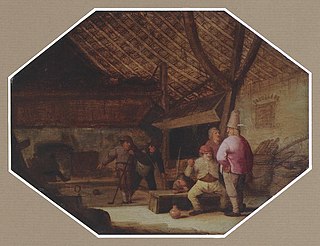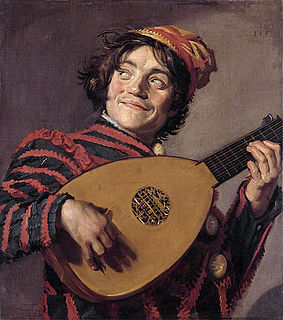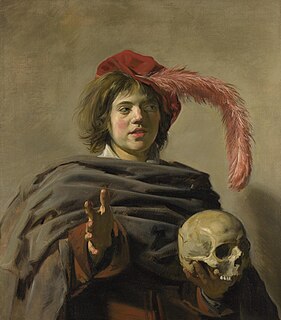| A Youth with a Jug | |
|---|---|
 | |
| Artist | Judith Leyster |
| Year | 1633 |
| Medium | Oil on canvas |
| Dimensions | 89 cm× 85 cm(35 in× 33 in) |
A Youth with a Jug is a 1633 oil painting by Judith Leyster currently in a private collection. [1]
| A Youth with a Jug | |
|---|---|
 | |
| Artist | Judith Leyster |
| Year | 1633 |
| Medium | Oil on canvas |
| Dimensions | 89 cm× 85 cm(35 in× 33 in) |
A Youth with a Jug is a 1633 oil painting by Judith Leyster currently in a private collection. [1]
This painting was first documented as being in the collection of Arthur Kay who published his "Treasure Trove of Art" in 1939, including this Youth with a Jug as one of a series on the five senses painted by Judith Leyster. [2] Later the five paintings were documented as being in the collection of Paris gallery owner Georges Wildenstein, Buenos Aires by 1941. [1] By the 1950s the paintings were split up on the art market and this one was attributed to Leyster by the researcher Frima Fox Hofrichter in 1991 when it was sold to the present owner. In 2002 three of the paintings were brought back together and attributed to Leyster's husband Jan Miense Molenaer. Since then the remaining two have come on the market, but new examination has brought doubts as to whether all five paintings were ever a set. This one remains attributed to Leyster.
The painting depicts a kannekijker, one who peers wistfully into the bottom of an empty jug as if by wishing more wine will appear in it. [1] The painting is unsigned, but the chemise of the boy is similar to that of another painting attributed to Leyster in the Bristol Art Gallery. [1]
The painter Frans Hals also made a youthful kannekijker in his Two laughing boys with mug of beer :

Frans Hals the Elder was a Dutch Golden Age painter, chiefly of individual and group portraits and of genre works, who lived and worked in Haarlem.

The Frans Hals Museum is a museum located in Haarlem, the Netherlands.

Rachel Ruysch was a Dutch still-life painter from the Northern Netherlands. She specialized in flowers, inventing her own style and achieving international fame in her lifetime. Due to a long and successful career that spanned over six decades, she became the best documented woman painter of the Dutch Golden Age.

Judith Jans Leyster was a Dutch Golden Age painter. She painted genre works, portraits and still lifes. Although her work was highly regarded by her contemporaries, Leyster and her work became almost forgotten after her death. Her entire oeuvre was attributed to Frans Hals or to her husband, Jan Miense Molenaer, until 1893. It wasn't until the late 19th century that she was recognized for her artistic abilities.

Jan Miense Molenaer, was a Dutch Golden Age genre painter whose style was a precursor to Jan Steen's work during Dutch Golden Age painting. He shared a studio with his wife, Judith Leyster, also a genre painter, as well as a portraitist and painter of still-life. Both Molenaer and Leyster may have been pupils of Frans Hals.

Cornelis Mahu was a Flemish painter of still lifes, genre paintings and seascapes who showed a very high level of craftsmanship in his compositions.

Bartholomeus Molenaer was a Dutch Golden Age genre painter.

Battle Between Carnival and Lent is an oil painting by Dutch artist Jan Miense Molenaer, located in the Indianapolis Museum of Art, which is in Indianapolis, Indiana. Painted roughly 1633–1634, it depicts a brawl between rowdy peasants, representing Carnival, and a group of monks, representing Lent. The rowdy combatants are armed with comical implements representing their sides, such as a peasant with a beer tankard battling a monk armed with fish.

The Lute Player is an oil-on-canvas painting from 1623 or 1624 now in the Louvre by the Haarlem painter Frans Hals, showing a smiling actor wearing a jester's costume and playing a lute.

Young Man with a Skull is an oil on canvas painting by the Dutch Golden Age painter Frans Hals, created in 1626-1628, now in the National Gallery, in London. The painting was previously thought to be a depiction of Shakespeare's Hamlet holding the skull of Yorick, but is now considered to be a vanitas, a reminder of the precarious nature of life and the inevitability of death.

The Fingernail Test is an oil-on-canvas Dutch Golden Age painting that has been attributed to either Frans Hals or Judith Leyster, painted in 1626 and now in the Metropolitan Museum of Art, New York City.

Self-portrait by Judith Leyster is an Dutch Golden Age painting in oils now in the collection of the National Gallery of Art in Washington DC. It was offered in 1633 as a masterpiece to the Haarlem Guild of St. Luke. It was attributed for centuries to Frans Hals and was only properly attributed to Judith Leyster upon acquisition by the museum in 1949. The style is indeed comparable to that of Hals, Haarlem's most famous portraitist.

The Jolly Toper is a 1629 oil painting by Judith Leyster in the collection of the Rijksmuseum that is on long term loan to the Frans Hals Museum since 1959. It was acquired by the museum as a painting by Frans Hals and was attributed to Leyster by the researcher Juliane Harms in 1927.

The Serenade is a 1629 oil painting by Judith Leyster in the collection of the Rijksmuseum. It was attributed for centuries to Frans Hals until Wilhelm von Bode saw it in the Six collection in 1883. He noticed the prominent "J" in the signature, and attributed it to Jan Hals. This is one of seven paintings first properly attributed to Leyster by Hofstede de Groot ten years later in 1893.

The Last Drop is a c. 1629 oil painting by Judith Leyster in the John G. Johnson collection of the Philadelphia Museum of Art. It was regarded as a work by Frans Hals until 1903, when it was noticed that it is signed 'JL*' on the tankard.

Standing Cavalier is a painting by Judith Leyster in the Royal Collection. It is the only painting by Leyster with a provenance that reaches back to the 18th-century.

Young man playing the lute is an oil painting by Judith Leyster in the collection of the Rijksmuseum, and is a period copy of the same subject by Frans Hals. It was acquired by the museum as a painting by Frans Hals and was skipped by the researcher Juliane Harms in 1927, being finally attributed to Leyster by Seymour Slive in 1974.

A Boy and a Girl with a Cat and an Eel is a 1635 oil painting by Judith Leyster that is now in the National Gallery, London.

A Game of Tric-Trac is a painting by Judith Leyster from 1630.

Unequal Love is a painting made in about 1631 by the Dutch Golden Age painter Judith Leyster. It is in the collection of the Galleria Nazionale d'Arte Antica, Rome.